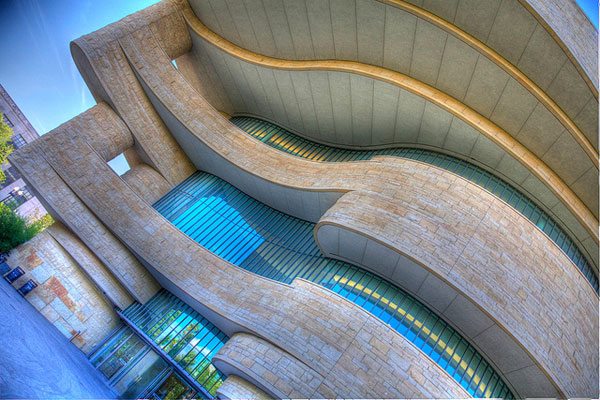
January 19, 2018; Washington Post
Last week, the Smithsonian National Museum of the American Indian in Washington, D.C., opened its doors to a provocative new exhibition, titled “Americans,” that addresses “the fabrication of Indian identity by the dominant, European-derived American culture,” reports Philip Kennicott in the Washington Post.
The museum opened on the National Mall in 2004 to mixed reviews. The museum faces a regular struggle of how to balance two conflicting imperatives—namely, to tell the stories of hundreds of different American Indian nations while at the same time satisfying critic demands for a unifying narrative. An NPR report by Lynn Neary as the museum neared its first anniversary noted that, “Critics have praised the building and mostly panned the exhibitions.” Kennicott has been prominent among those critics. But with the opening of “Americans,” Kennicott writes, “the museum and its curators have found a voice, and one every museum should emulate. They are going to address difficult questions with nuance and courage.”
The premise of “Americans,” which was curated by Cecile R. Ganteaume and Paul Chaat Smith, is that images—some accurate, many not—of American Indians have permeated every aspect of American life, and have persisted “in the collective consciousness,” even as the people those images are based upon have been marginalized. One “long, tall gallery” is filled from floor to ceiling with objects bearing images of American Indians, while a series of side galleries tackle important historical moments that have contributed to perceptions that many museum visitors may have about American Indians—sometimes as romanticized figures, other times through sanitized or exaggerated interpretations of history.
This excerpt from a news release on the museum’s website captures the gist of the exhibition, which is slated to run into 2022:
Sign up for our free newsletters
Subscribe to NPQ's newsletters to have our top stories delivered directly to your inbox.
By signing up, you agree to our privacy policy and terms of use, and to receive messages from NPQ and our partners.
“Pervasive, powerful, at times demeaning, the images and objects featured in ‘Americans’ reveal the deep connection between Indians and non-Indians, even while their actual interaction may be far less frequent,” said Kevin Gover, director of the Smithsonian’s National Museum of the American Indian. “Our hope is that visitors will come away from the exhibition not only more aware of the pervasive presence of Indian imagery and words in their lives, but also with a new understanding of important historical events they thought they knew.”
Kennicott states that the exhibition “forces viewers to confront some of the thorniest issues of contemporary culture in uncomfortable and complicated ways, including identity politics, cultural appropriation and historical revisionism.” He offers as one example the long-simmering effort to change the name of the NFL’s Washington, D.C., franchise. He cites a gallery in the new exhibition that explores the 19th-century Indian Removal Act, which “cleared much of the South of native people who had largely taken up American identity, forming settled communities and participating in American self-governance.” He notes that through this act, “the homelands of the Choctaw, Chickasaw, Creek, Cherokee and others had been ethnically cleansed.”
The disconnect for many Americans, he observes, is this:
Many people have a fondness for [American Indian] imagery because they have been surrounded by it their entire lives. They grow up eating Land O’ Lakes butter, joining the YMCA’s Indian Guides (now renamed the Adventure Guides), and driving around in Jeep Cherokees. Just like Thanksgiving, the emotions connected to these innumerable products, narratives, clubs and popular culture references can’t be extricated from American life. As curator Chaat Smith explains in an introductory video, “We’re in your head, we’re in your pantry, we’re in your garage.”
When NPQ covered the opening of the Smithsonian’s National Museum of African American Museum and Culture in 2016, we noted the challenges of creating a visitor experience that is both appealing/enjoyable and true to the narratives that need to be shared. The same challenges certainly apply for the Museum of the American Indian. It sounds like the “Americans” exhibition may be an example of striking the right balance. As Kennicott notes, the exhibition will not let visitors off easy; but it will be hard to miss the point of a visitor experience based on “an objectivity that may placate no one but will provoke actual thoughtfulness.”—Eileen Cunniffe












